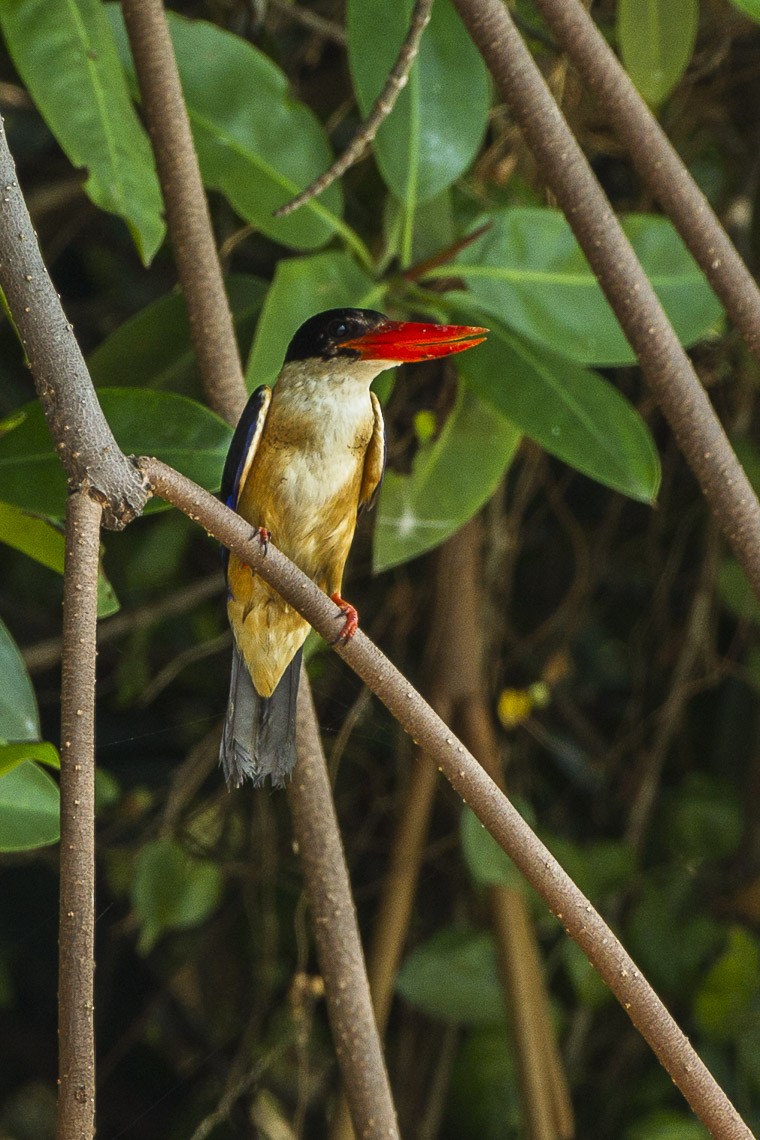Black-capped Kingfisher
A species of Typical Woodland Kingfishers Scientific name : Halcyon pileata Genus : Typical Woodland Kingfishers
Black-capped Kingfisher, A species of Typical Woodland Kingfishers
Botanical name: Halcyon pileata
Genus: Typical Woodland Kingfishers
Content
Description General Info
 Photo By Francesco Veronesi , used under CC-BY-SA-2.0 /Cropped and compressed from original
Photo By Francesco Veronesi , used under CC-BY-SA-2.0 /Cropped and compressed from original Description
This kingfisher is about 28 centimetres (11 in) long. The adult has purple-blue wings and back, black head and shoulders, white neck collar and throat, and rufous underparts. The large bill and legs are bright red. In flight, large white patches or "mirrors" at the base of the primaries are visible on the blue and black wings. Sexes are similar, but juveniles are a duller version of the adult and show streaks on the throat. The call of this kingfisher is a cackling ki-ki-ki-ki-ki. Usually seen on coastal waters and especially in mangroves, it is easily disturbed. It perches conspicuously and dives to catch fish, and also feeds on large insects. The flight of the black-capped kingfisher is rapid and direct, the short rounded wings whirring. The breeding season is in summer. The nest is a tunnel in an earth bank. A single clutch of 4-5 round, white eggs is typical. A subspecies palawanensis has been described, but the species is considered to be monotypic with no clear plumage differences across its range. 
Size
28 cm
Life Expectancy
10 years
Nest Placement
Tree
Feeding Habits
Black-capped Kingfisher preys on insects, frogs, reptiles, fish, and crabs. It forages from elevated perches, often changing spots, to hunt or scavenge, especially targeting tidal areas for crabs during low tide.
Habitat
Black-capped Kingfisher predominantly inhabits coastal and freshwater environments, commonly found in mangrove forests, estuaries, and along riverbanks. Their geographical range spans broader temperate and tropical/subtropical regions, frequenting habitats such as deciduous forests near waterways, lagoons, rice fields, and forest clearings. They adapt to both inland and coastal ecosystems, including creeks, nipa palm groves, and gardens. Typically residing in lowlands, black-capped Kingfisher may also be located at higher elevations reaching up to 1525 meters, occasionally ventured as far as 3300 meters.
Dite type
Piscivorous
General Info
Feeding Habits
Bird food type
Distribution Area
The species is found mainly near the coast in mangrove forests and along estuaries and rivers. The distribution ranges from India (including the Andaman and Nicobar Islands where they occur even on remote islands like Narcondam), Sri Lanka, Kansu, Shansi, Korea, Malay Peninsula, Thailand, Burma, Ryukyu Islands, Bangladesh, Hainan, Philippines (Palawan, Balabac, Basilan, Tawi Tawi), Borneo, Sumatra east to Sulawesi where it occurs only in winter. Vagrants in winter have been recorded in Pakistan, while movements related to rainfall may lead to their being found far inland and away from their usual distribution. 
Species Status
Not globally threatened.